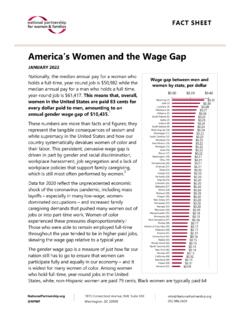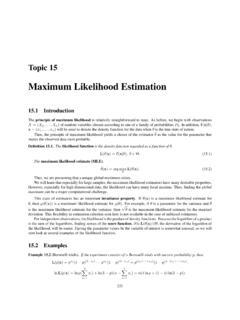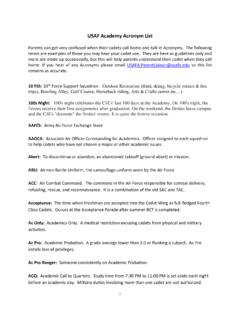Transcription of Soil Temperature Variations With Time and Depth Model ...
1 Soil Temperature Changes with Time and Depth : Theory, NofzigerIntroduction Model Simplifications FAQ Glossary Bibliography and ContributorsSoil Temperature Variations With Time and Depth Soil Temperature fluctuates annually and daily affected mainly by Variations in air Temperature and solar radiation. The annual variation of daily average soil Temperature at different depths can be estimated using a sinusoidal function (Hillel, 1982; Marshall and Holmes, 1988; Wu and Nofziger, 1999). This program estimates daily soil temperatures and displays these values as functions of time or Depth for user defined input parameters.
2 Model DescriptionThe annual variation of daily average soil Temperature at different depths is described with the following sinusoidal function ( Hillel, 1982): where T(z,t) is the soil Temperature at time t (d) and Depth z (m), T a is the average soil Temperature (oC), A0 is the annual amplitude of the surface soil Temperature (oC), d is the damping Depth (m) of annual fluctuation and t0 is the time lag (days) from an arbitrary starting date (taken as January 1 in this software) to the occurrence of the minimum Temperature in a year. The damping Depth is given by d = (2D h/ )1/2, where Dh is the thermal diffusivity and = 2 /365 d-1.
3 Assumptions and SimplificationsThe sinusoidal Temperature Model was derived by solving the following partial differential equation ( Hillel, 1982 ; Marshall and Holmes, 1988): where T(z,t) is the soil Temperature at time t and Depth z and Dh is the thermal diffusivity. file:///C|/SoilPhysics/software/ (1 of 8)2/16/2005 4:52:46 PMSoil Temperature Changes with Time and Depth : Theory, NofzigerThe following assumptions are employed in the derivation of the Temperature Model : 1. A sinusoidal Temperature variation at the soil surface z = 0. That iswhere Ta is the average soil Temperature , A0 is the amplitude of the annual Temperature function, t0 a time lag from an arbitrary starting date (selected as January 1 in this software) to the occurrence of the minimum Temperature in a year.
4 2. At infinite Depth , the soil Temperature is constant and is equal to the average soil The thermal diffusivity is constant throughout the soil profile and throughout the Asked Questions1. How well does the Model predict soil temperatures? Figure 1 compares measured and predicted soil temperatures at 4 depths for a site (located at degrees North and degrees East) in Hebei Province, China (Wu and Nofziger, 1999). The parameters in the Model in this case were obtained from measured soil surface temperatures, clay content and average water content of each layer.
5 Clearly the Model does a good job predicting the mean daily temperatures. file:///C|/SoilPhysics/software/ (2 of 8)2/16/2005 4:52:46 PMSoil Temperature Changes with Time and Depth : Theory, NofzigerFigure 1. Measured mean and predicted soil temperatures at four depths based on measured soil surface temperatures. 2. Can I use air temperatures to estimate soil temperatures? Figure 2 compares the measured and predicted soil temperatures for the same site when Model parameters are obtained from air temperatures instead of measured soil surface temperatures (Wu and Nofziger, 1999).
6 The Model consistently underestimates soil temperatures by about 2 degrees Celsius. These data and those of others suggests that good estimates of temperatures under bare soils can be obtained using by simply increasing the maximum and minimum air temperatures by 2 degrees when defining the Model parameters. The correction for soils that are not bare will likely be less since those soil temperatures are somewhat less due to shading from the plants. file:///C|/SoilPhysics/software/ (3 of 8)2/16/2005 4:52:46 PMSoil Temperature Changes with Time and Depth : Theory, NofzigerFigure 2.
7 Comparison of measured and predicted soil temperatures at four depths based upon air temperatures at the What is the effect of soil wetness on soil Temperature distributions? The thermal diffusivity of the soil is the ratio of the thermal conductivity of the soil to the volumetric heat capacity of the soil. The conductivity and volumetric heat capacity increase with water content so the diffusivity is also dependent upon soil water content. For mineral soils, the thermal diffusivity increases with water content at low water contents and then gradually decreases with increasing water contents at high water contents.
8 This is illustrated in the Figure 3 for three clay contents and for three bulk density values. The volumetric heat capacity fot the three bulk densities is shown in Figure :///C|/SoilPhysics/software/ (4 of 8)2/16/2005 4:52:46 PMSoil Temperature Changes with Time and Depth : Theory, Nofzigerfile:///C|/SoilPhysics/software/ (5 of 8)2/16/2005 4:52:46 PMSoil Temperature Changes with Time and Depth : Theory, NofzigerFigure 3. Variation of thermal conductivity and diffusivity with soil water content, clay content, and bulk density for mineral 4. Volumetric heat capacity for three bulk densities for soils whose thermal conductivity and diffusivity are shown in Figure impact of water content upon estimated soil Temperature can be observed by viewing results for this range of thermal diffusivities.
9 Figure 3 is based on research cited by of deVries (1963, 1975) and Farouki (1986). Heat transport involves soils as a mixture of mineral particles (primarily quartz and clay), organic matter, water, and air. For a mineral soils, contributions of organic matter and air to specific heat capacity and thermal conductivity of the composite soil system are usually negligible. Thermal diffusivity values change by approximately 30% or less for water contents greater than m3 m-3. Glossaryfile:///C|/SoilPhysics/software/ (6 of 8)2/16/2005 4:52:46 PMSoil Temperature Changes with Time and Depth : Theory, NofzigerAmplitude: Amplitude is a parameter characterizing the annual variation of soil Temperature around an average value.
10 If the variation in Temperature within a day is averaged out over many years, the annual amplitude is one-half the difference between this annual averaged maximum and annual averaged minimum temperatures within a year. Damping Depth : Damping Depth is a constant characterizing the decrease in amplitude with an increase in distance from the soil surface. It is defined as (2Dh/ )1/2, where D h is the thermal diffusivity and is the frequency of a Temperature fluctuation. For annual fluctuation =2 /365 d-1. Thermal diffusivity: Thermal diffusivity is the change in Temperature produced in a unit volume by the quantity of heat flowing through the volume in unit time under a unit Temperature gradient.





